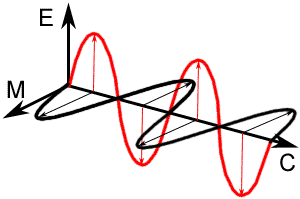
Topic 3: The Electromagnetic Spectrum
The first requirement for remote sensing is to have an energy source to illuminate the target. This energy is in the form of electromagnetic radiation and derived primarily from the sun in the form of light.
All electromagnetic radiation has fundamental properties and behaves in predictable ways according to the basics of wave theory. Electromagnetic radiation consists of an electrical field (E) which varies in magnitude in a direction perpendicular to the direction in which the radiation is traveling, and a magnetic field (M) oriented at right angles to the electrical field. Both these fields travel at the speed of light (c).

Two characteristics of electromagnetic radiation are particularly important for understanding remote sensing. These are the wavelength and frequency.

Wavelength and frequency are related by the following formula:

The wavelength is the length of one wave cycle, which can be measured as the distance between successive wave crests. Wavelength is usually represented by the Greek letter lambda (l). Wavelength is measured in metres (m) or some factor of metres such as nanometres (nm, 10-9 metres), micrometres (mm, 10-6 metres) or centimetres (cm, 10-2 metres). Frequency refers to the number of cycles of a wave passing a fixed point per unit of time. Frequency is normally measured in hertz (Hz), equivalent to one cycle per second, and various multiples of hertz.
The electromagnetic spectrum ranges from the shorter wavelengths (including gamma and x-rays) to the longer wavelengths (including microwaves and broadcast radio waves). There are several regions of the electromagnetic spectrum which are useful for remote sensing.
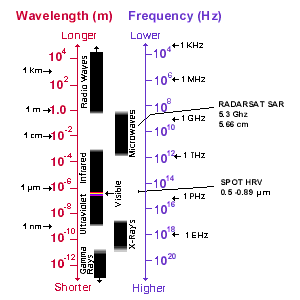
The light which our eyes can detect forms the visible spectrum. It is important to note how small a portion of the electromagnetic spectrum is represented by the visible region.
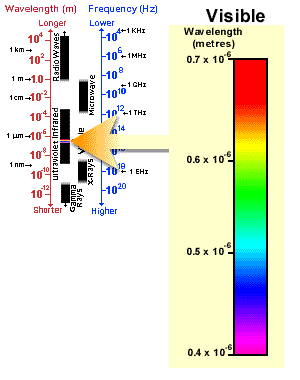
Radiation Interaction with the Earth
Radiation that is not absorbed or scattered in the atmosphere can reach and interact with the Earth's surface. There are three (3) forms of interaction that can take place when energy strikes, or is incident (I) upon the surface. These are: absorption (A); transmission (T); and reflection (R).

Reflection: reflected light is what we know as color; i.e. chlorophyll in plants reflects green light.
Absorbtion: the incident energy is not reflected or transmitted but is transformed into another form, such as heat i.e. a rock, or absorbed by chlorophyll in the process of photosynthesis.
Transmission: when energy propagates through a medium, what is not absorbed or reflected will be transmitted through i.e. an ultraviolet filter on a camera absorbs UV rays but allows the remaining energy to expose the film. Changes in density can also slow the velocity resulting in refraction such as light through a prism.
Radiation Interaction with the Atmosphere
The Earth's atmosphere acts as a filter to remove radiation such as cosmic rays, gamma rays, x-rays, UV rays, and large portions of the electromagnetic spectrum through the process of absorbtion and scattering by gases, water vapor, and particulate matter (dust).
Scattering occurs when particles or large gas molecules present in the atmosphere interact with and cause the electromagnetic radiation to be redirected from its original path. There are three (3) types of scattering which take place: Raleigh Scatter, Mie Scatter, Non-selective Scatter.

Rayleigh Scatter occurs when particles are very small compared to the wavelength of the radiation. These could be particles such as small specks of dust or nitrogen and oxygen molecules. This is the cause of the blue sky; it is red in the mornings and evenings because light has a longer path through the atmosphere and the blue wavelengths (or shorter wavelenths) are scattered so completely that it leaves only red (the longer) wavelengths.
Mie Scattering occurs when the particles in the atmosphere are the same size as the wavelengths being scattered. Dust, pollen, smoke and water vapour are common causes of Mie scattering which tends to affect longer wavelengths. Mie scattering occurs mostly in the lower portions of the atmosphere where larger particles are more abundant, and dominates when cloud conditions are overcast.
Non-Selective Scattering occurs when the particles are much larger than the wavelength of the radiation. Water droplets and large dust particles can cause this type of scattering and causes fog and clouds to appear white to our eyes because blue, green, and red light are all scattered in approximately equal quantities (blue+green+red light = white light).
In addition to the scattering of EM radiation, the atmosphere also absorbs electromagnetic radiation. The three main constituents which absorb radiation are Ozone, Carbon Dioxide, and Water Vapor.
Ozone serves to absorb the harmful (to most living things) ultraviolet radiation from the sun. Without this protective layer in the atmosphere our skin would burn when exposed to sunlight.
Carbon Dioxide absorbs in the far infrared portion of the spectrum which is related to thermal heating and results in a 'greenhouse' effect.
Water Vapor absorbs energy depending upon its location and concentration, and forms a primary component of the Earth's climatic system.
The absorbtion by various constituents in the atmosphere results in limiting portions of the electromagnetic radiation from reaching the Earth. For remote sensing, this limits us to portions of the electromagnetic spectrum where radiation is not strongly absorbed.
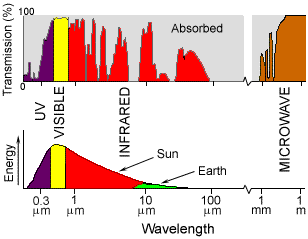
The visible part of the EM spectrum ranges from 0.4 mm (micrometers) to 0.7 mm (micrometers). The region from 0.7 to 0.9 mm is known as the photographic or color infrared (CIR).
Color InfraRed (CIR) is also referred to as Photo Infrared and falls within the very-near infrared (VNIR) portion of the EM spectrum and forms part of the Reflected Infrared radiation. Reflected IR is distinct from Thermal IR which is radiation in the form of Heat emitted by an object.
Vegetation Spectral Reflection
Spectral reflectance in vegetation varies depending on the chlorophyll content, leaf shape, area, and number together with overall plant structure. Spectral reflectance between species can be clearly distinguished in the very near infrared (VNIR) used for color IR photography.
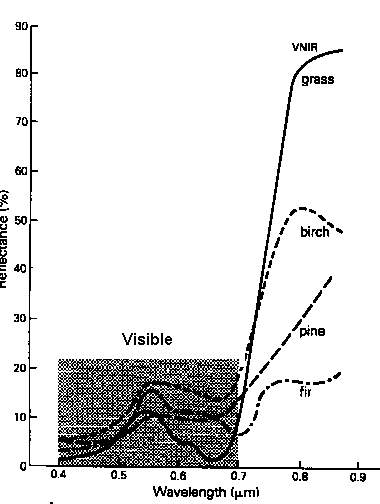
Within a leaf, incident blue and red wavelengths are absorbed by chlorophyll in the process of photosynthesis. Incident green wavelengths are partially reflected by chlorophyll. Incident infrared (IR) energy is strongly scattered and reflected by cell walls in the mesophyll.
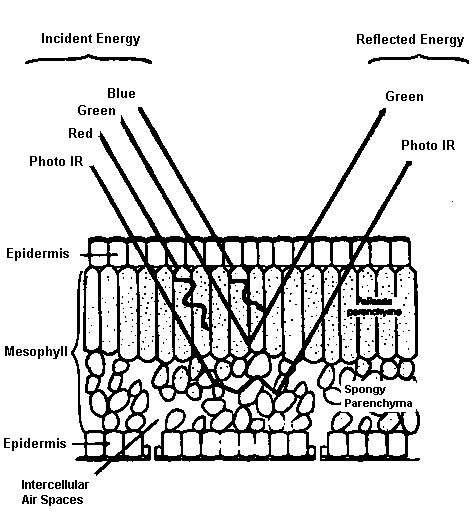
Normal & False Color Photographs/Images
Normal color photographs of the Earth's surface are images as we would see them with normal vision. Blue, green and red and combinations of these primary colors are represented by blue, red and green in the color photos.
False color is where wavelength ranges or bands in the EM spectrum are designated by a selected color. In Color Infrared film, red represents the near infrared band, green represents the red band, blue represents the green band, and black represents the blueband. The result of this shift in color is to create a photograph which emphazises vegetation, and is therefore much more useful than normal or black & white photography.
| Object reflectance at Earth's Surface | BLUE | GREEN | RED | NEAR IR |
| Colors presented on normal color prints | BLUE | GREEN | RED | Not Active |
| Lense filter use in CIR Photography | Wratten #12 Blue Absorbing Filter | |||
| Colors appearing in CIR prints | BLACK | BLUE | GREEN | RED |
Normal Color |
False Color (CIR) |
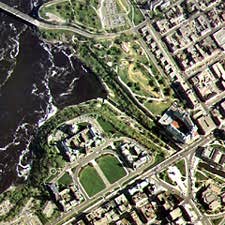 |
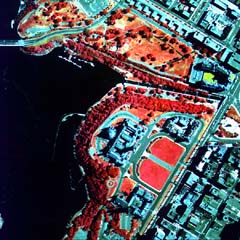 |
Features on the surface of the Earth have reflectance characteristics which can help identify a feature. One important characteristic is the object's albedo, which is the percentage of the energy that is reflected from an object. Objects with high albedo are brighter, those with low albedo are darker. False color images also provide a way to determine the spectral signature.
| Subject | Description | Color Film | IR Color Film |
| Healthy Vegetation | Broadleaf Needle-leaf |
Green Green |
Red to Magenta Reddish brown to Purple |
| Stressed Vegetation | Previsual Stage Visual Stage |
Green Yellowish Green |
Pink to Blue Cyan |
| Autumn Leaves | Red to Yellow | Yellow to White | |
| Clear Water | Blue-green | Dark Blue to Black | |
| Silty Water | Light Green | Light Blue | |
| Shadows | Blue | Black | |
| Water Penetration | Good | Moderate to Poor | |
| Contact Descrimination | Land & Water | Poor to Fair | Excellent |
| Rock Outcrop | Red Bed | Red | Yellow (Yellow) |
Objects also have visual characteristic which allow us to differentiate them. These characteristics include size, shape, pattern, tone, association, and texture.

Airphoto Example Grey Level
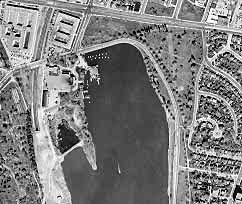
Air photo Example CIR
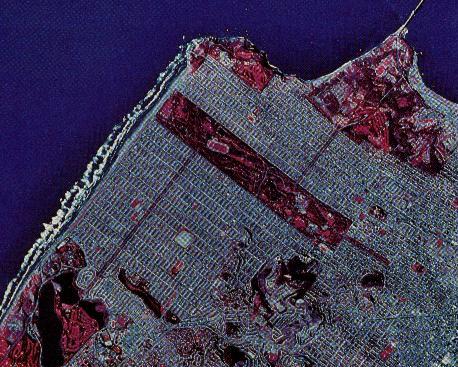
Arnold: p. 14-22